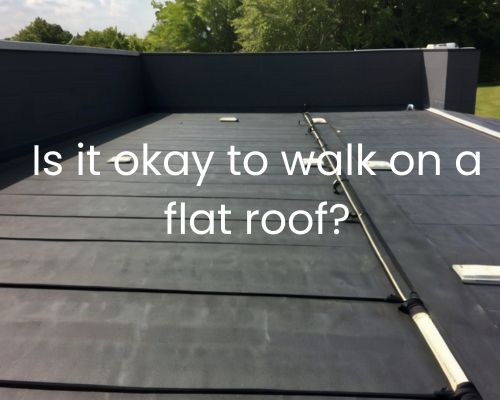Walking on a flat roof is a common practice for homeowners and contractors alike. Whether it’s for maintenance, repair, or simply to enjoy the view, walking on a flat roof can be a necessary task.
However, the question remains: is it okay to walk on a flat roof? Let us know it with David Spade of Roofing West Palm Beach.

The answer is not a simple yes or no. It depends on several factors, such as the type of roofing material, the age of the roof, and the weight capacity of the roof.
For example, a flat roof made of asphalt or rubber is generally safe to walk on, while a metal or fiberglass roof may not be able to support the weight of a person.
In addition to the type of roofing material, the age of the roof is also an important factor to consider. An older roof may be more prone to damage and may not be able to support the weight of a person as well as a newer roof.
It’s important to inspect the roof for any signs of damage or deterioration before walking on it. If you’re unsure about the condition of your roof, it’s best to consult with a professional roofing contractor.
Assessing Roof Safety and Preparation
Before walking on a flat roof, it is important to assess the safety of the roof and prepare accordingly.
This section will cover the key factors that you should consider before walking on a flat roof. These include the understanding of flat roof structure and materials, pre-walk inspection and identifying hazards, and safety precautions and equipment.
Understanding Flat Roof Structure and Materials
Flat roofs are common in residential and commercial buildings, and they are typically constructed with a slight slope or pitch to allow for proper drainage.
Flat roofs can be made from a variety of materials, including built-up roofing, EPDM, TPO, rubber, and other flat roofing materials.
It is important to understand the structure and materials of your flat roof to assess its safety. Flat roofs can be dangerous to walk on if they are not in good condition or have not been properly maintained.
Cracks, holes, and punctures in the roof can be hazardous and may cause you to fall through the roof.
Pre-Walk Inspection and Identifying Hazards
Before walking on a flat roof, it is important to conduct a pre-walk inspection to identify any potential hazards.
Look for debris, such as branches or leaves, that may be on the roof and could cause you to slip or lose your footing.
Check for any holes or punctures in the roof that could be dangerous.
Inspect the condition of the roof, including any cracks or other signs of wear and tear.
If you notice any dangerous conditions, such as a hole or other damage, do not attempt to walk on the roof. Instead, contact a professional roofing contractor to assess and repair the roof.
Safety Precautions and Equipment
When walking on a flat roof, it is important to take safety precautions and use the appropriate equipment.
Wear shoes with good traction to prevent slipping, and consider wearing a safety harness to prevent falling.
Use a stable ladder to access the roof, and make sure the ladder is secure and in good condition.
If you are not comfortable walking on the roof or do not have the appropriate equipment, it is best to hire a professional roofing contractor to perform the work.
Professional roofing contractors have the experience and equipment necessary to safely walk on a flat roof and identify any potential hazards.
Walking on a Flat Roof
Walking on a flat roof can be necessary for various reasons, including maintenance and repair work. However, it is important to take necessary precautions to avoid any accidents.
In this section, we will discuss the best practices for foot traffic on a flat roof and the maintenance and repair considerations.
Best Practices for Foot Traffic
When walking on your roof, it is important to wear stable and slip-resistant shoes. Avoid wearing high heels, sandals, or shoes with smooth soles.
Instead, wear shoes with rubber soles that provide good traction.
Before walking on your roof, inspect it for any damage or weak spots.
Check for any loose roofing felt, glass, plastic, or fiberglass. Also, make sure that the gutter, vents, skylights, and drains are clear of any debris.
When scaling a ladder, ensure that you place it on a secure base with a slope of 4-to-1.
Additionally, allow the top of the ladder to extend three feet above the top of the roof. This setup reduces the risk of slipping and falling when ingressing and egressing.
While walking on the roof, distribute your weight evenly and avoid stepping on the edges or corners of the roof.
If possible, walk on the joists or support beams rather than the roofing material itself.
Maintenance and Repair Considerations
Walking on a flat roof can cause damage if not done correctly. Therefore, it is important to take necessary precautions to avoid any damage to the roofing system.
When walking on your roof, avoid dragging heavy objects or tools that can puncture or damage the roofing material. Also, avoid walking on the roof during extreme weather conditions such as heavy rain, ice, or snow.
If you notice any damage to the roofing material while walking on your roof, repair it as soon as possible. Delaying the repair can cause further damage and increase the repair costs. If you cannot do the repair work, you can have Roofing West Palm Beach do it for you.
